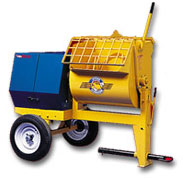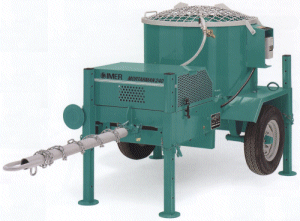For precast concrete countertops, your mixer is one of the biggest investments you will make at around $2000 and up, so buying just what you need, and not more than you need, is very important.
There are three basic types of concrete mixers available:
- drum mixer
- mortar mixer
- vertical shaft mixer
All of these types come in a variety of sizes. Some can be run either by a gasoline engine or an electric motor. And some drum and many mortar mixers are available with either steel or plastic drums.
Drum Mixers
Drum mixers are what most people think of when they consider a mixer for making concrete. Drum mixers have a round drum with fins or vanes fixed to the inside of the drum. As the drum turns, the concrete is moved and lifted by the fins, and gravity causes the ingredients to tumble and to mix together.
Drum mixers are designed to mix relatively fluid concrete that has significant quantities of large aggregate in it; in other words, basic concrete of a consistency most people are used to and expect to encounter.
Thorough, effective and efficient mixing depends on the tumbling action of the mixer and on the concrete mixture’s physical characteristics to aid in the mixing process. The more fluid the mix, the more effective the mixing action. Typically stiff, very low slump, no slump and all-sand mixes are difficult to mix because they tend to stick to the walls of the drum and not tumble and churn. Often frequent hand scraping is necessary to remove stiff, clumped material that gets packed against the fins.
Mortar Mixers
Mortar mixers, sometimes called stucco mixers, have a horizontal shaft with paddles attached to the shaft. The drum of the mixer is semi-cylindrical and is stationary during mixing. The shaft and paddles rotate to mix the concrete in the drum.
Mortar mixers are designed primarily to mix all-sand mixes, typically used for making stucco and for making brick and block mortar. These mixes tend to be stiff, sticky and completely lack large aggregate. Thorough, effective and efficient mixing depends on the mixing action of the paddles and not so much on the concrete mixture’s physical characteristics. It is for this reason that mortar mixers tend to be more versatile because they can mix both highly fluid and very stiff concrete mixes.
Mortar mixers can usually handle concrete with up to 3/8” aggregate. The downside of mixing larger aggregate is that it significantly increases wear on the drum and on the paddle blades, which often use rubber strips that act like squeegees. Wear is reduced significantly with more fluid mixtures, and is significantly increased with stiff mixtures in mixers with plastic drums.
Vertical Shaft Mixers
Vertical shaft mixers are similar to mortar mixers in that the wide, shallow, circular mixing pan is stationary. The drive shaft rises vertically through the center of the pan, and paddles and scrapers of various configurations move and mix the concrete.
Vertical shaft mixers are less common than the previous two types. However, they make up for this with increased mixing speed and efficiency. Vertical shaft mixers are capable of mixing most types of concrete, both stiff and fluid, but the discharge method may make stiff mixes more difficult to deal with.
With drum and mortar mixers, the entire drum is tilted to discharge the concrete. With vertical shaft mixers, the mixing pan is stationary and a relatively small door in the bottom of the pan is the discharge port. The concrete is discharged by opening the door and letting the mixing paddles scrape the concrete over the hole, letting gravity handle the rest.
It’s best to match the type of mixer to the type of concrete you plan on using when making concrete countertops. If you only work with fluid concrete, then a drum style mixer will meet your needs. However, if you work with all-sand mixes, or very stiff concrete, then a mortar or vertical shaft mixer may be a better choice.
Once you’ve determined the type of mixer, then select the size, power supply, and drum material based on your particular needs. I’ll discuss these factors in another post.



